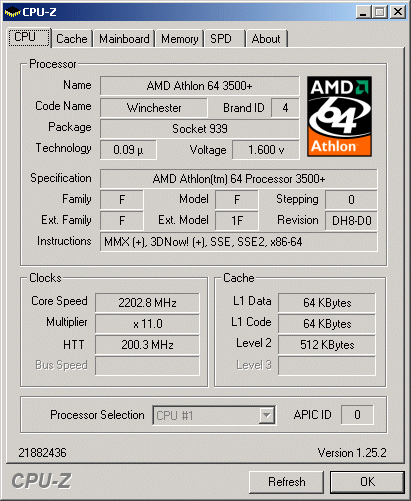The Mother of All CPU Charts Part 2
Socket 939: June 2004 To Today
| Athlon64 3000+ to 4000+ | June 2004 to today |
| Athlon FX-53 and 55 | June 2004 to today |
For Socket 939, which was created as the successor to Socket 940 in the desktop range, there are four different CPU versions. The Newcastle is based on a 130-nm process and has a 512 kB L2 cache, while the Athlon64 3400+ is the only one to work with 200 MHz hyper transport. All other processors can fall back on the faster interface with 250 MHz, making a data transfer rate of 4 GB/s possible. Available only recently is the Winchester core, which is also equipped with a 512 kB L2 cache, but is manufactured in an 90-nm process. Mainly due to the Cool-and-Quiet feature, the Athlon achieves a minimum heat loss of a sensational 3 watts - the maximum performance (full capacity) of 33 watts is also astonishingly low.
The fourth variation is the Athlon64 FX in the classic Clawhammer core. This is sold for Socket 939 with 2.4 GHz and 2.6 GHz as FX-53 and FX-55. These very expensive CPUs have a larger L2 cache with 1 MB.
The Athlon64 4000+, which is identical to the FX-53, causes some confusion. The only difference is that the FX CPUs have a multiplier that is freely adjustable upwards and downwards, while the Athlon64 class is can only be adjusted freely downwards. A significant basis for very high performance is the dual-channel DDR400 memory interface without registered protocol, which is common to all CPUs. AMD plans to expand the 90-nm technology further and to introduce dual-core CPUs in 2005.
Get Tom's Hardware's best news and in-depth reviews, straight to your inbox.
Current page: Socket 939: June 2004 To Today
Prev Page Socket 754: September 2003 To June 2004 Next Page Socket 939: June 2004 To Today, ContinuedTom's Hardware is the leading destination for hardcore computer enthusiasts. We cover everything from processors to 3D printers, single-board computers, SSDs and high-end gaming rigs, empowering readers to make the most of the tech they love, keep up on the latest developments and buy the right gear. Our staff has more than 100 years of combined experience covering news, solving tech problems and reviewing components and systems.


